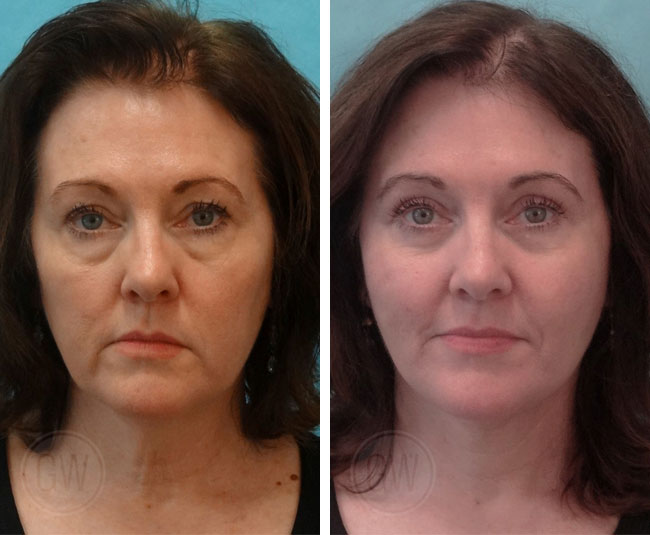This website contains imagery which is only suitable for audiences 18+.

Deep Plane Facelift
WHAT IS DEEP PLANE FACELIFT?
A Deep Plane Facelift is an advanced cosmetic surgery technique designed to alter the face by repositioning the deeper layers of facial tissue and muscles. This procedure goes beyond the superficial treatment of the skin and the SMAS (Superficial Musculoaponeurotic System) layer, targeting the deeper structural tissues of the face. A Deep Plane Facelift can effectively help address facial ptosis, deep nasolabial folds, and excess skin.
Unlike Traditional Facelifts that primarily tighten the skin, a Deep Plane Facelift involves repositioning the facial musculature. This technique allows for results that avoid too much tension on the skin that can sometimes lead to a ‘pulled’ appearance.
WHO IS A GOOD CANDIDATE FOR A DEEP PLANE FACELIFT?
Suitable candidates for a Deep Plane Facelift are generally those who are experiencing advanced signs of facial ageing, such as:
- Significant Facial Ptosis: Deep Plane Facelifts may be suitable for individuals with pronounced skin laxity of the facial tissues, which cannot be adequately addressed by other procedures.
- Deep Nasolabial Folds: Prominent nasolabial folds (the lines running from the sides of the nose to the corners of the mouth).
- Jowls and excess Neck Skin: This procedure can help treat jowls and excess skin around the neck, which can in turn increase jawline definition and neck contour.
- Overall Health: Candidates should be in good general health, without any medical conditions that impair healing or increase the risk of surgery
- Non-smokers: Smoking can significantly affect the healing process, so it’s important for patients to be non-smokers or those who can quit smoking well in advance of surgery and throughout the recovery period.
- Realistic Expectations: It’s important for candidates to have a clear understanding of what a Deep Plane Facelift can achieve. A positive outlook and specific, but realistic goals are crucial.
During the initial consultation, Dr. Guy Watts will assess these factors, discuss the individual’s aesthetic goals and determine whether a Deep Plane Facelift is the most appropriate course of action.
.

WHAT CAN A DEEP PLANE FACELIFT DO FOR ME?
- Addresses deep facial structures
- Lift and reposition the midface, resulting in significant changes in nasolabial folds and excess cheek skin
- Repositions entire facial units instead of just stretching the skin
- Effectively addresses jowls and increases the definition of the jawline and neck
- Helps reduce the appearance of deep-set wrinkles and lines, particularly in the lower face and around the mouth
REQUEST AN APPOINTMENT
HOW IS A DEEP PLANE FACELIFT PERFORMED?
The Deep Plane Facelift procedure, as performed by Dr. Guy Watts, involves several steps:
- Anaesthesia: The surgery is performed under general anaesthesia for patient comfort and safety.
- Making the Incisions: Incisions for a Deep Plane Facelift are similar to those made during a Traditional Facelift. They typically start in the hairline at the temples, continuing around the ear and possibly extending into the lower scalp. However, the focus is on deeper tissue layers rather than just the skin.
- Addressing Deep Tissues: A Deep Plane Facelift involves the repositioning of the deeper layers of facial muscles and tissues. Dr. Watts meticulously works to release and reposition these layers, changing the facial contours and addressing areas of excess skin and deep creases.
- Skin Re-draping and Excess Skin Removal: After adjusting the deeper tissues, the skin is re-draped over the altered contours. Unlike Traditional Facelifts, the tension is not on the skin but on the deeper tissue layers, which helps achieve a more comprehensive result. Excess skin is then removed as necessary.
- Closing the Incisions: The incisions are closed with sutures, so the scars are as discreet as possible.
The Deep Plane Facelift is a highly specialised procedure that requires advanced surgical skills and a thorough understanding of facial anatomy.
RECOVERY AFTER A DEEP PLANE FACELIFT
Recovery from a Deep Plane Facelift involves a period of rest and careful post-operative care:
- Immediate Post-Operative Period: After the surgery, patients can expect some swelling, bruising, and discomfort. Bandages are applied to the face to reduce swelling and support the new facial contours.
- First Few Days: Pain medication and antibiotics may be prescribed to manage discomfort and prevent infection. It’s important to keep the head elevated and avoid any strenuous activities.
- Follow-Up Visits: Patients will have follow-up appointments with Dr. Watts to monitor their healing process, remove sutures, and provide additional care instructions.
- Returning to Normal Activities: Most patients can return to work and light activities within two to three weeks post-surgery. However, it is recommended to avoid vigorous physical activity for at least four to six weeks.
- Long-Term Care: Following Dr. Watts’s instructions for wound care, sun protection and a good lifestyle is crucial for optimising recovery and maintaining the results of the surgery.
Dr. Watts and his team provide comprehensive guidance throughout the recovery process, making sure each patient’s experience is as comfortable and successful as possible.
DOWNLOAD DR WATTS’ GUIDE TO COST OF SURGERY

FAQS ABOUT DEEP PLANE FACELIFT SURGERY
How does a deep plane facelift differ from a traditional facelift?
A Deep Plane Facelift targets the deeper layers of facial tissues and muscles, providing more comprehensive and lasting results compared to a Traditional Facelift that primarily addresses the skin and superficial tissues.
What is the expected recovery time for a deep plane facelift?
Recovery can vary, but most patients can return to normal activities within two to three weeks, with full recovery taking up to several months for all swelling to subside and incisions to heal.
What are the risks of deep plane facelift surgery?
As with any surgical procedure, a Deep Plane Facelift carries certain risks and potential complications. Dr. Guy Watts makes sure all patients are fully informed about these risks, which may include:
- Anaesthesia Risks: As the surgery is performed under general anaesthesia, there are associated risks such as allergic reactions and respiratory issues.
- Bleeding and Infection: There is a risk of bleeding and infection, although these are relatively rare. Proper post-operative care and following prescribed medication regimens can mitigate these risks.
- Scarring: While incisions are made in specific locations to reduce visible scarring, the degree of scarring can vary depending on individual healing processes and skin type.
- Skin Irregularities: Changes in skin sensation, contour irregularities, or skin discolouration may occur, although these are typically temporary.
- Prolonged Swelling and Bruising: Some patients may experience prolonged swelling and bruising, but these typically resolve with time.
Dr. Watts prioritises patient safety and employs meticulous surgical techniques to reduce these risks. It’s important for patients to disclose their full medical history and follow all pre- and post-operative instructions to reduce the likelihood of complications.
Medical References for Deep Plane Facelift
- Deep Plane Facelift – StatPearls
- Deep Plane Facelift
- What is a deep plane facelift? – American Board of Facial Cosmetic Surgery
Next Steps on Your Plastic Surgery Journey
PLEASE TAKE INTO CONSIDERATION
| Any surgical or invasive procedure carries risks. Before proceeding, you should seek a second opinion from an appropriately qualified health practitioner. |
About Dr. Guy Watts – MED0001539378
FRACS (Plas) – Specialist Plastic Surgeon In Perth WA
Dr. Guy Watts is a Specialist Plastic Surgeon (AHPRA MED0001539378) with an extensive career that spans across renowned plastic surgery clinics worldwide. His experience has been honed through invaluable experiences at esteemed establishments such as the New York Eye and Ear Infirmary and the renowned Pitanguy Clinic in Brazil.
Having collaborated with the foremost cosmetic plastic surgeons on a global scale, Dr. Watts has chosen to return to Perth after a 17-year journey of intensive training and invaluable professional experience to bring the latest practices and technology in cosmetic plastic surgery to his patients.
Dr. Watts is a Fellow of the Royal Australasian College of Surgeons (FRACS) and a Member of the Australian Society of Plastic Surgeons (ASPS), Australasian Society of Aesthetic Plastic Surgeons (ASAPS) and the International Society of Aesthetic Plastic Surgeons (ISAPS).
Read about the potential Risks and Complications of Surgery
Read the Patient Information and Resources
About CLINISPA
Clinispa is Dr Watts’ bespoke medical clinic performing Cosmetic Aesthetic treatments. At Clinispa, we offer advanced clinical treatments in a luxurious and calming environment, tailored to support your skin’s health and appearance.
Clinispa aesthetic services are performed by Dr Guy Watts’ nursing professionals, who have a passion for and solid understanding of facial aesthetics.
All Clinispa clients are considered individually, with a personalised treatment plan consisting of advanced scientific approaches to cosmetic aesthetics. We incorporate innovative technologies in conjunction with superiorly formulated skin care.
For more information about the full range of Clinispa Aesthetic of Cosmetic Treatments visit the Clinispa website









